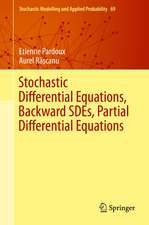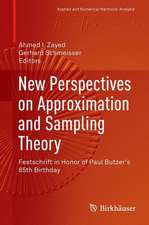Dynamical Systems with Applications using Maple™
Autor Stephen Lynchen Limba Engleză Paperback – dec 2009
Preț: 538.76 lei
Preț vechi: 633.83 lei
-15% Nou
Puncte Express: 808
Preț estimativ în valută:
103.10€ • 108.41$ • 85.18£
103.10€ • 108.41$ • 85.18£
Carte tipărită la comandă
Livrare economică 17 aprilie-01 mai
Preluare comenzi: 021 569.72.76
Specificații
ISBN-13: 9780817643898
ISBN-10: 0817643893
Pagini: 509
Ilustrații: XVIII, 500 p. 216 illus.
Dimensiuni: 155 x 235 x 27 mm
Greutate: 0.73 kg
Ediția:2nd ed. 2010
Editura: Birkhäuser Boston
Colecția Birkhäuser
Locul publicării:Boston, MA, United States
ISBN-10: 0817643893
Pagini: 509
Ilustrații: XVIII, 500 p. 216 illus.
Dimensiuni: 155 x 235 x 27 mm
Greutate: 0.73 kg
Ediția:2nd ed. 2010
Editura: Birkhäuser Boston
Colecția Birkhäuser
Locul publicării:Boston, MA, United States
Public țintă
GraduateCuprins
A Tutorial Introduction to Maple.- Differential Equations.- Planar Systems.- Interacting Species.- Limit Cycles.- Hamiltonian Systems, Lyapunov Functions, and Stability.- Bifurcation Theory.- Three-Dimensional Autonomous Systems and Chaos.- Poincar#x00E9; Maps and Nonautonomous Systems in the Plane.- Local and Global Bifurcations.- The Second Part of Hilbert#x2019;s Sixteenth Problem.- Linear Discrete Dynamical Systems.- Nonlinear Discrete Dynamical Systems.- Complex Iterative Maps.- Electromagnetic Waves and Optical Resonators.- Fractals and Multifractals.- Chaos Control and Synchronization.- Neural Networks.- Simulation.- Examination-Type Questions.- Solutions to Exercises.
Recenzii
From the reviews of the second edition:
"The text treats a remarkable spectrum of topics and has a little for everyone. It can serve as an introduction to many of the topics of dynamical systems, and will help even the most jaded reader, such as this reviewer, enjoy some of the interactive aspects of studying dynamics using Maple." —UK Nonlinear News (1st Edition)
"This book covers standard material for an introduction to dynamical systems theory. Written for both advanced undergraduates and new postgraduate students, this book is split into two distinctive parts: continuous systems using ordinary differential equations and discrete dynamical systems. Lynch uses the Maple package as a tool throughout the text to help with the understanding of the subject. The book contains over 250 examples and exercises with solutions and takes a hands-on approach. There are over 300 individual figures including about 200 Maple plots, with simple commands and programs listed at the end of each chapter...This publication will provide a solid basis for both research and education in nonlinear dynamical systems." —The Maple Reporter (1st Edition)
"The book will be useful for all kinds of dynamical systems courses…. [It] shows the power of using a computer algebra program to study dynamical systems, and, by giving so many worked examples, provides ample opportunity for experiments. … [It] is well written and a pleasure to read, which is helped by its attention to historical background." —Mathematical Reviews (1st Edition)
"… a very nice tutorial on Maple in which quite a few mathematical and graphical commands are illustrated. A student could quickly work through this tutorial and then be ready to do quite a bit with Maple….[The second part of Hilbert’s 16th problem] is not the topic encountered in most ODE texts, even if the question has been open for 100 years! …Lynch’s book provides great references, as well as Maple code that could be easily modified by readers who have the tools to quickly engage in quite sophisticated numerical experimentation." —SIAM Review (1st Edition)
"A student or scientist, who works through some chapters of the book, learns a good deal about the presented mathematical concepts and possibilities of the symbolic algebra package to assist the researcher in understanding his mathematical model." —Dynamical Systems Magazine (1st Edition)
“This book, that provides an introduction to the study of dynamical systems with the aid of the algebraic package Maple, is the second edition of the well known classical book of Stephen Lynch … . a well written and highly readable introduction to the numerical study dynamical systems with Maple at an introductory level that covers many topics of this subject and can be used as a very valuable resource for many courses in applied mathematics and modelization in engineering and physical sciences.” (Manuel Calvo, Zentralblatt MATH, Vol. 1193, 2010)
"The text treats a remarkable spectrum of topics and has a little for everyone. It can serve as an introduction to many of the topics of dynamical systems, and will help even the most jaded reader, such as this reviewer, enjoy some of the interactive aspects of studying dynamics using Maple." —UK Nonlinear News (1st Edition)
"This book covers standard material for an introduction to dynamical systems theory. Written for both advanced undergraduates and new postgraduate students, this book is split into two distinctive parts: continuous systems using ordinary differential equations and discrete dynamical systems. Lynch uses the Maple package as a tool throughout the text to help with the understanding of the subject. The book contains over 250 examples and exercises with solutions and takes a hands-on approach. There are over 300 individual figures including about 200 Maple plots, with simple commands and programs listed at the end of each chapter...This publication will provide a solid basis for both research and education in nonlinear dynamical systems." —The Maple Reporter (1st Edition)
"The book will be useful for all kinds of dynamical systems courses…. [It] shows the power of using a computer algebra program to study dynamical systems, and, by giving so many worked examples, provides ample opportunity for experiments. … [It] is well written and a pleasure to read, which is helped by its attention to historical background." —Mathematical Reviews (1st Edition)
"… a very nice tutorial on Maple in which quite a few mathematical and graphical commands are illustrated. A student could quickly work through this tutorial and then be ready to do quite a bit with Maple….[The second part of Hilbert’s 16th problem] is not the topic encountered in most ODE texts, even if the question has been open for 100 years! …Lynch’s book provides great references, as well as Maple code that could be easily modified by readers who have the tools to quickly engage in quite sophisticated numerical experimentation." —SIAM Review (1st Edition)
"A student or scientist, who works through some chapters of the book, learns a good deal about the presented mathematical concepts and possibilities of the symbolic algebra package to assist the researcher in understanding his mathematical model." —Dynamical Systems Magazine (1st Edition)
“This book, that provides an introduction to the study of dynamical systems with the aid of the algebraic package Maple, is the second edition of the well known classical book of Stephen Lynch … . a well written and highly readable introduction to the numerical study dynamical systems with Maple at an introductory level that covers many topics of this subject and can be used as a very valuable resource for many courses in applied mathematics and modelization in engineering and physical sciences.” (Manuel Calvo, Zentralblatt MATH, Vol. 1193, 2010)
Textul de pe ultima copertă
"The text treats a remarkable spectrum of topics and has a little for everyone. It can serve as an introduction to many of the topics of dynamical systems, and will help even the most jaded reader, such as this reviewer, enjoy some of the interactive aspects of studying dynamics using Maple."
—UK Nonlinear News (Review of First Edition)
"The book will be useful for all kinds of dynamical systems courses…. [It] shows the power of using a computer algebra program to study dynamical systems, and, by giving so many worked examples, provides ample opportunity for experiments. … [It] is well written and a pleasure to read, which is helped by its attention to historical background."
—Mathematical Reviews (Review of First Edition)
Since the first edition of this book was published in 2001, Maple™ has evolved from Maple V into Maple 13. Accordingly, this new edition has been thoroughly updated and expanded to include more applications, examples, and exercises, all with solutions; two new chapters on neural networks and simulation have also been added. There are also new sections on perturbation methods, normal forms, Gröbner bases, and chaos synchronization.
The work provides an introduction to the theory of dynamical systems with the aid of Maple. The author has emphasized breadth of coverage rather than fine detail, and theorems with proof are kept to a minimum. Some of the topics treated are scarcely covered elsewhere. Common themes such as bifurcation, bistability, chaos, instability, multistability, and periodicity run through several chapters.
The book has a hands-on approach, using Maple as a pedagogical tool throughout. Maple worksheet files are listed at the end of each chapter, and along with commands, programs, and output may be viewed in color at the author’s website. Additional applications and further links of interest may be found at Maplesoft’sApplication Center.
Dynamical Systems with Applications using Maple is aimed at senior undergraduates, graduate students, and working scientists in various branches of applied mathematics, the natural sciences, and engineering.
ISBN 978-0-8176-4389-8
§
Also by the author:
Dynamical Systems with Applications using MATLAB®, ISBN 978-0-8176-4321-8
Dynamical Systems with Applications using Mathematica®, ISBN 978-0-8176-4482-6
—UK Nonlinear News (Review of First Edition)
"The book will be useful for all kinds of dynamical systems courses…. [It] shows the power of using a computer algebra program to study dynamical systems, and, by giving so many worked examples, provides ample opportunity for experiments. … [It] is well written and a pleasure to read, which is helped by its attention to historical background."
—Mathematical Reviews (Review of First Edition)
Since the first edition of this book was published in 2001, Maple™ has evolved from Maple V into Maple 13. Accordingly, this new edition has been thoroughly updated and expanded to include more applications, examples, and exercises, all with solutions; two new chapters on neural networks and simulation have also been added. There are also new sections on perturbation methods, normal forms, Gröbner bases, and chaos synchronization.
The work provides an introduction to the theory of dynamical systems with the aid of Maple. The author has emphasized breadth of coverage rather than fine detail, and theorems with proof are kept to a minimum. Some of the topics treated are scarcely covered elsewhere. Common themes such as bifurcation, bistability, chaos, instability, multistability, and periodicity run through several chapters.
The book has a hands-on approach, using Maple as a pedagogical tool throughout. Maple worksheet files are listed at the end of each chapter, and along with commands, programs, and output may be viewed in color at the author’s website. Additional applications and further links of interest may be found at Maplesoft’sApplication Center.
Dynamical Systems with Applications using Maple is aimed at senior undergraduates, graduate students, and working scientists in various branches of applied mathematics, the natural sciences, and engineering.
ISBN 978-0-8176-4389-8
§
Also by the author:
Dynamical Systems with Applications using MATLAB®, ISBN 978-0-8176-4321-8
Dynamical Systems with Applications using Mathematica®, ISBN 978-0-8176-4482-6
Caracteristici
New edition has been thoroughly updated and expanded to include more applications, examples, and exercises, all with solutions Two new chapters on neural networks and simulation have also been added Wide variety of topics covered with applications to many fields, including mechanical systems, chemical kinetics, economics, population dynamics, nonlinear optics, and materials science Accessible to a broad, interdisciplinary audience Includes supplementary material: sn.pub/extras












